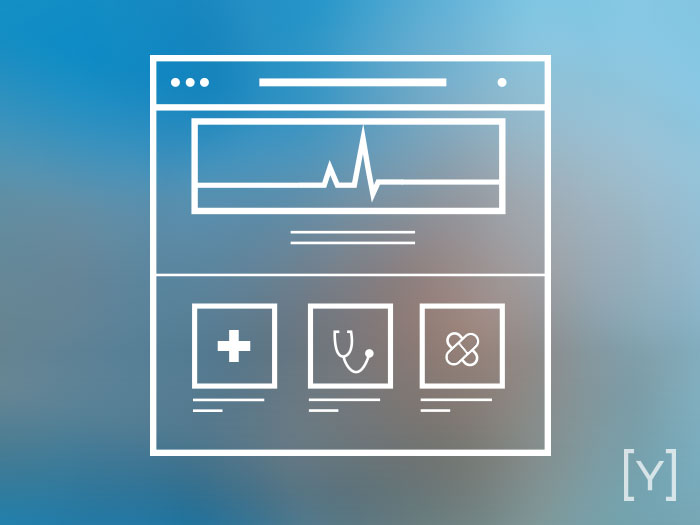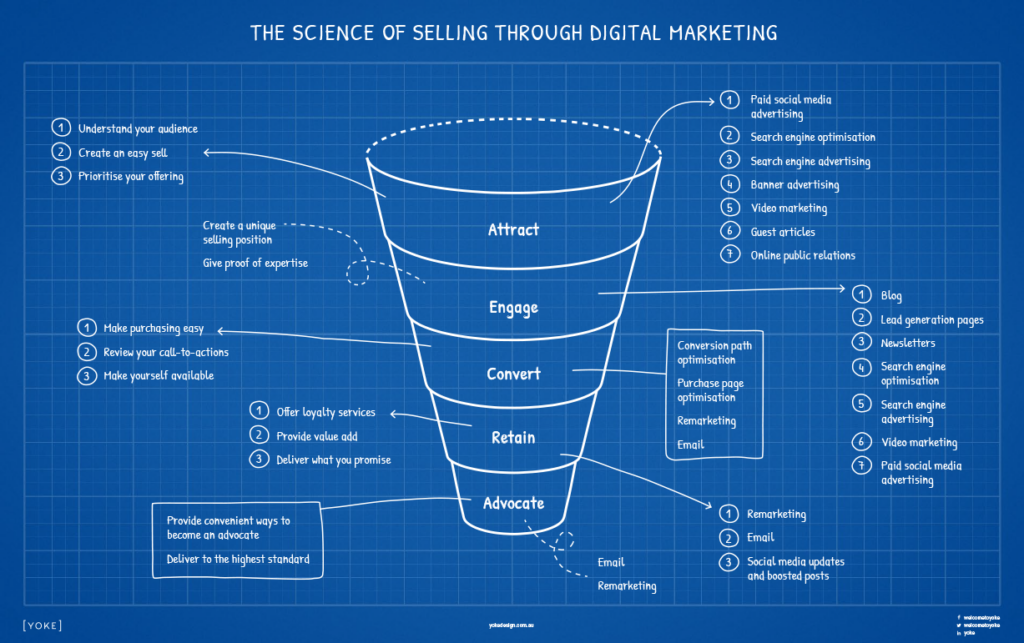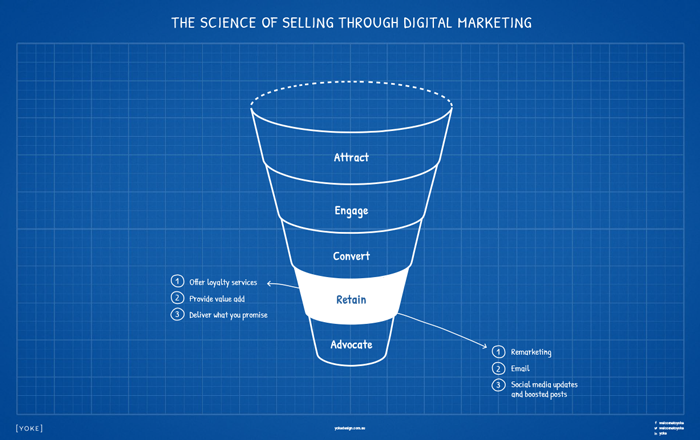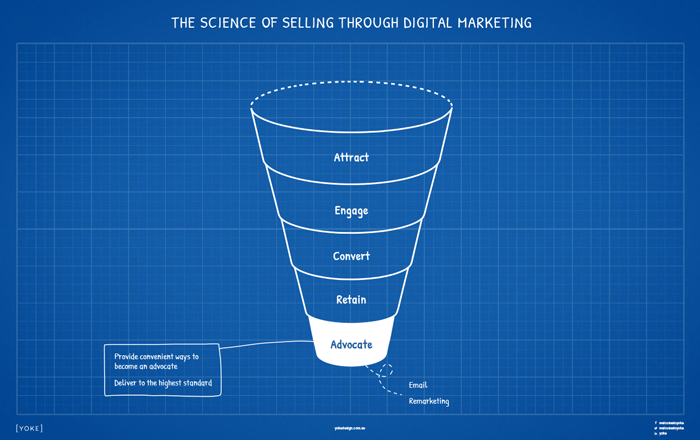The science of digital marketing for service based businesses
Before the Internet came about, service businesses relied on traditional marketing channels and sales representatives to push their services to consumers. Marketing and sales functions often worked disconnected from each other, rarely uniting their efforts for a more effective lead management process.

While this method still works in some cases, the digital sphere and digital lead management have evolved drastically since the appearance of the Internet, giving most service businesses an easier, more cost-effective access to their target customers.
Businesses operating in the service industry are still unsure of the possibilities digital can deliver; websites and other digital platforms are often misunderstood as mere marketing tools for generating high-level awareness, with little to no selling capabilities. Indeed, eCommerce is commonly considered to be the domain of products only.
The reality is that digital can deliver the same benefits to service businesses as it does to product sellers. This article gives service businesses a step-by-step guide on how to make digital marketing and sales work for them.
So how do you apply a streamlined digital strategy to achieve success in marketing and selling of services? Simply put, the basic digital rules of product marketing and selling also apply to service marketing and selling.
In product selling and eCommerce, a sales funnel is used to drive prospects on a journey from awareness to purchase to ultimately advocating your business. This model also provides a clear path of action for service businesses who wish to experience the benefits of digital.

The stages of the sales funnel can be used for any services company when devising a digital strategy. In this article we will look into each stage in detail and provide tips on how to make the funnel work for service businesses.
Each of the five stages has specific messaging and channels that work best with the needs of the target audience at that stage, with the overall goal to move the qualified prospects down further in the sales funnel.
You can also download the cheat sheet to digital marketing and sales for service businesses.
STEP 1. ATTRACT
This is the first stage of the funnel, and also the one that should have the broadest reach. The idea behind the attraction phase is to cast your net wide and create awareness within your target audience.

If your messaging is enticing and relevant enough for the target audience, they’ll perform an initial action, e.g. sign up to your newsletter or click through to your website, which moves them on to the next stage of the funnel.
In terms of messaging, there are four points to take into account when crafting your marketing copy to attract your target audience:
Understand your audience
In order to attract your ideal target audience, you first need to understand them. What are their pain points? What about their motivations, goals and behaviours?
The purpose of this exercise is that it’s only after answering these questions that you really gain an understanding of your target audience and can tailor your messaging and channel strategy to respond to their needs.
What many businesses get wrong when crafting their marketing and sales copy is that they concentrate on writing about themselves, rather than addressing the needs of their target customers.
There’s a famous saying that illustrates this point perfectly: “People don’t want quarter-inch drill bits. They want quarter-inch holes.”
What this means is that by focusing on your target audience’s needs (e.g. quarter-inch holes), as opposed to your service features (e.g. quarter-inch drill bits), you show how your service is the solution to fulfilling your target audience’s needs.
Particularly in the first stage of the sales funnel, people quite often are looking for a solution to a problem they are facing or they might not even be aware that they have a problem. You should keep this in mind when choosing your messaging and channels for this stage by making the intended target audience aware that they have a problem and then positioning your business as the solution to the problem.
Create an easy sell
If there is only one lesson you take from this article, let it be this one; make your service offering easy to understand. In the online space, you don’t have the luxury to explain your services in detail. This is especially true during the initial stages of the sales funnel, when people aren’t yet actively engaged with your service offering and don’t want to dedicate a lot of time to get to know your business.
Making sure that your audience understands your service offering is very important, but the information about your business and offering needs to be served in bite-sized, easily digestible pieces. If you can’t do this, you take the risk of losing the interest of your valuable target audience even before you had the chance to engage them properly.
Prioritise your offering
Often businesses can sell more than one service, but you can’t be everything to everyone; you need to prioritise your target audiences and service offerings and build your digital strategy around this premise.
You need to structure your website, content strategy and channel strategy in such a way that’ll see you dedicate more time and attention to promoting and selling the more profitable services to the more profitable target audiences.
After prioritising your services and audiences, take a look at your website. Because your website is your digital home, any digital strategy implementation should start here.
Present the more important services more prominently on your website and navigation menus. This also applies to promoting your services; dedicate more time to blog about topics that you know tie closely to your more profitable services and dedicate more advertising dollars to advertise the more profitable services on Google AdWords and social media channels.
Choose channels with wide reach
Most businesses justifiably place a lot of importance on their website design, user experience and conversion optimisation. This is best practice, but only half of the solution to make the sales funnel work for your business.
Promoting your service offering, website and content needs a channel strategy that takes into account the distinct characteristics of each channel and their optimal place in the sales funnel to lead your target audience further down towards conversion and, ideally, advocacy.
In the attraction stage, your aim is to generate general awareness for your business and services within your target audience. For this purpose, channels with wide reach and good targeting options work well to get your target audience’s attention:
- Paid social media advertising
- Search engine optimisation
- Search engine advertising
- Banner advertising
- Video marketing
- Guest articles and public relations
Step 2. Engage
In the first stage of the sales funnel, your target audience is experiencing a problem and you’re creating awareness of your business by placing the business in front of your audience.

During the ‘Engage’ phase, your target audience is now aware of your business, but needs educating on how to choose the correct service solution that solves their problem and why your service offering is the best of the bunch.
Create a unique selling proposition
Be it on your website, social media channels or advertisements, it’s important to differentiate your services from your competitors’. Before coming up with the copy, answer the following two questions; what makes you unique? What does your business do that others don’t?
After you have found the answers, go back to the needs of your target audience, and combine these with your unique selling proposition; this is your business’ sweet spot. Tailor your content strategy around the sweet spot and remember to keep writing any and all your content from this angle, be it website copy, ad messaging, social media updates, newsletters and so on.
Give proof of expertise
In the engagement phase of the sales funnel you need to convince your prospects that you’re indeed the best option for them. Your target audience is probably evaluating a few other service businesses similar to yours and trying to determine which one of them they should go with.
This is your chance to give your prospects as much proof as possible that you’re the expert in the field, got a nice portfolio of happy customers under your belt and that you really understand their needs.
To do this, you need to create credibility by having a full library of insightful articles in your blog that address your prospects’ pain points, display a showcase of positive testimonials and reviews from past clients, have in-depth case studies as well as logos of awards or large partner and client businesses you may have.
These all work like the good old fashioned word-of-mouth to build your credibility and reduce the feeling of stress and uncertainty that people often feel when faced with a decision.
Choose channels that let you demonstrate your expertise
The channel strategy for the engagement stage should revolve around promoting your content and expertise, which is why channels that you own or direct content that you own to, play a big role in making this stage work for your business:
- Blog
- Lead generation pages
- Newsletters
- Search engine optimisation and Search engine advertising
- Video marketing
- Paid social media advertising
STEP 3. CONVERT
Your business has attracted a prospect and engaged them to evaluate your services. They are now on the brink of entering the third stage of the funnel, the conversion stage, but how do you get them over the line? You need to remove the last pieces of friction that stand between hesitation and purchase.

Make purchasing easy
Within the services industry, many businesses make it difficult for prospects to make a purchase, either not explaining their pricing clearly enough or worse still, not making purchasing an option at all.
You need to make purchasing as easy as possible for your prospect. Do not make them look for the ‘buy’ button, but give them clear call-to-actions as to what to do on each page of your website and other digital assets.
If you offer different service packages, present these on your website and communicate the differences and prices of each clearly. When asking for the prospect’s details online, make forms easy to fill out and don’t ask for unnecessary information. Most importantly, make your services available for purchase online; connect your services to an eCommerce platform and you’ll have another revenue stream.
Review your call-to-actions
Ensure your call-to-actions are well laid out, accessible and inviting. When in the earlier stages of the sales funnel you might have encouraged your target audience to read an article you wrote or to take a look at your lead generation page, in the conversion stage you’re telling your prospects to make a purchase.
Make sure these CTAs attract attention on your website and direct your prospects to the correct purchase page. And don’t forget that as with any CTA, they should always communicate just what the button will do and what the person will get out of clicking that button. Be it ‘Buy a gift voucher’, ‘Subscribe to this plan’ or ‘Book a course’, just make sure you avoid the all-too-common ‘Submit’.
Make yourself available
Because in the services industry customers are not left with any physical evidence of a purchase like with products, people judge their satisfaction with the service business purely on their service experience. It’s because of this that service should always be at the forefront of your company’s vision even before a purchase, and this should be visible on your website as well.
Your business can demonstrate your commitment to excellent service by publishing a comprehensive knowledge base or frequently asked questions to educate your prospective customers. Better yet, if you have the resources, a live chat is a popular way of building trust between your business and the prospective customers.
If your business can differentiate itself from the competitors by being there for a prospective customer when they have questions, your chances of converting them into a paying customer over your competitors without such option is significantly higher.
Choose channels that direct to purchase
At the conversion stage your website is your best friend, and the focus of your digital efforts should be on your purchase pages. This involves making sure that your purchase pages are easy to use, giving prospects an added incentive to make a purchase and optimising the visitor paths to these pages.
Specifically, you should have remarketing ads on Google AdWords and Facebook set up that remind prospects, who have already visited your website but haven’t necessarily purchased, of your business and your services.
Your website should also have a clear journey laid out to prospects that ultimately leads to the purchase pages through strong call-to-actions and incentives. The incentives increase the likelihood of a purchase as the value of the service is increased in the eyes of the prospects if you choose an incentive that is appropriate for your business and doesn’t cheapen your brand.
- Purchase page optimisation
- Google AdWords and Facebook remarketing
- Conversion path optimisation
- Incentives
STEP 4. RETAIN
Congratulations, you have converted a prospect into a customer. They get the service they purchased, your business gets the money and both go home happy, correct? Wrong – there is more to the sales funnel than that.

If research is anything to go by, 80% of your business’ future revenue will come from just 20% of your existing customers. And not just that, but finding new customers will cost you five times more than keeping an existing customer. This means that you need to keep your existing customers happy and make sure they come back.
Offer loyalty services
You can show your existing customers that you appreciate them by offering them exclusive access to new services that you plan to launch to the market soon, a cheaper rate or even a night out on the town.
You can use digital marketing tactics here as well by keeping an up-to-date customer database and connecting it to your email provider, such as MailChimp. After segmenting your customers, you can then easily send exclusive offers by email to those specific customer segments that you know will be highly profitable for your business in the long run.
Provide value add
New website technology has made the possibilities of value add services endless, and frankly, people have come to expect these to a certain extent. An example of value add is to provide your existing customers with the ability to perform re-occurring tasks online, such as paying of invoices or viewing production reports.
If your business is interested in going a step further, give your customers the option to sign up for an automated solution, where these re-occurring tasks will no longer need to be initiated by your customers.
Deliver what you promise
This is an obvious point, but make sure you can deliver on your offering; ensure your business can scale up and handle a jump in bandwidth for service requests from the website when your sales funnel starts working for you. Remember that a disgruntled customer will not return and will quite likely tell everyone else to stay away too.
Choose channels that reach your customers directly
In this stage you already have a converted customer and you’ll need digital channels that let you reach them directly.
You can upsell to them by using Google AdWords and Facebook remarketing, setting up the targeting rules so that ads promoting a specific service will only be shown to people who have purchased another, related service from your website in the last 180 days. These ads are likely to yield some good results because your existing customers are already familiar with your business and have warmed up to you.
Another effective channel to use in this phase is email. You are likely to have a nicely segmented customer list on your hands that gives you information about the services your customers have purchased, some of their demographics and, of course, email addresses.
Use the data you have to tailor specific content to each segment and offer them of something value in the email that you send. This could be an offer or an interesting article you have written; the important bit is to not spam people with irrelevant content.
- Google AdWords and Facebook remarketing
- Social media updates and boosted posts
STEP 5. ADVOCATE
This is a final piece of the puzzle and one that can bring your business big rewards. Not all of your customers will turn into advocates, but you can increase the chances by executing the previous four phases of the sales funnel successfully and demonstrate to your customers how much you value their advocacy.

Provide convenient ways to become an advocate
Your business should make it easy for your customers to advocate you. You can, for example, let your customers complete a review on your service delivery after each service session and give them the option to complete an online form or to send you an email. A great way to incentivise this is to offer your clients a discount on their next purchase if they provide a testimonial.
Deliver to the highest standard
This goes without saying, but the service you deliver to your clients should speak for itself and function as an incentive to turn customers into loyal advocates for your business. This in turn will help you secure more business from new customers.
Choose channels that give best targeting options
Again, the best way to reach your existing customers directly in the digital space is with email. Although you can always ask your staff to request customer feedback forms to be filled out in person, many people are now very comfortable with doing this online and it makes data handling easier for your business.
If you use marketing automation software, you can set up a rule that sends an email to a customer who has made multiple purchases within a specific timeframe, and is therefore more likely to leave you a positive testimonial or review.
Remarketing works during this stage very well too, especially if you are able to offer an incentive for leaving a testimonial for your business. As an example, with a specific set of website conversion rules set up in AdWords, it is possible for your business to target only those customers who have purchased three consulting sessions over the past three months and who have also visited at least five of your blog posts.
- Google AdWords and Facebook remarketing
Devising and implementing a digital strategy for any business is quite a bit of work. However, when the end result is a streamlined strategy that guides the target audience effectively through the sales funnel, the rewards are immense.
Not only will a business operating in the service industry gain an additional source of revenue, but also future-proof their business in preparation for the increasingly digital world.
Download our cheat sheet to digital marketing and sales for service businesses.